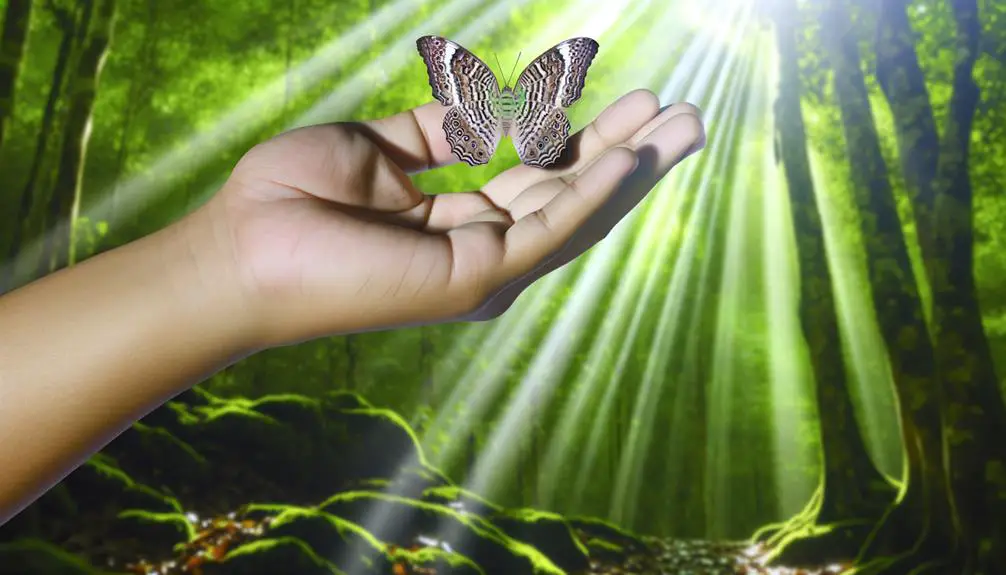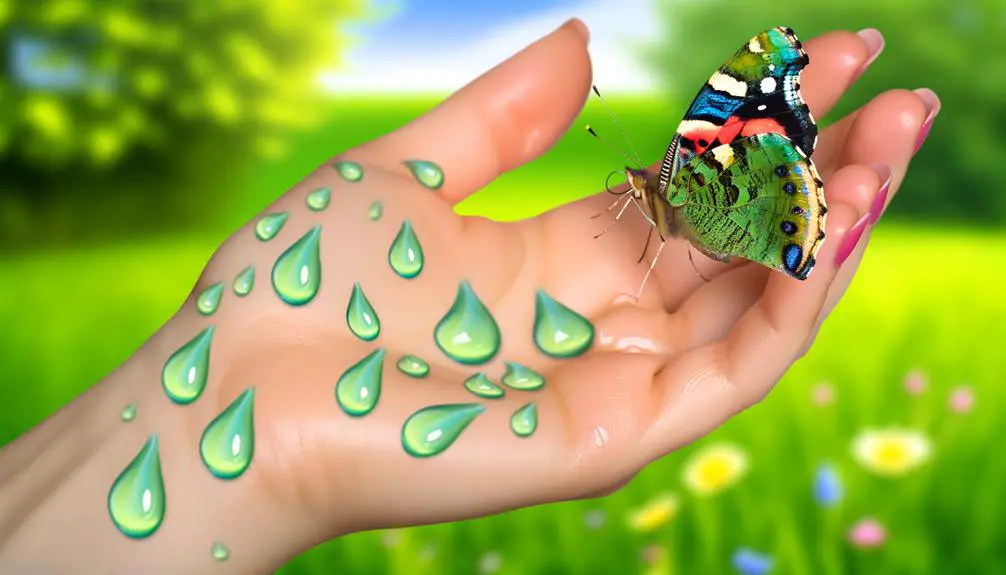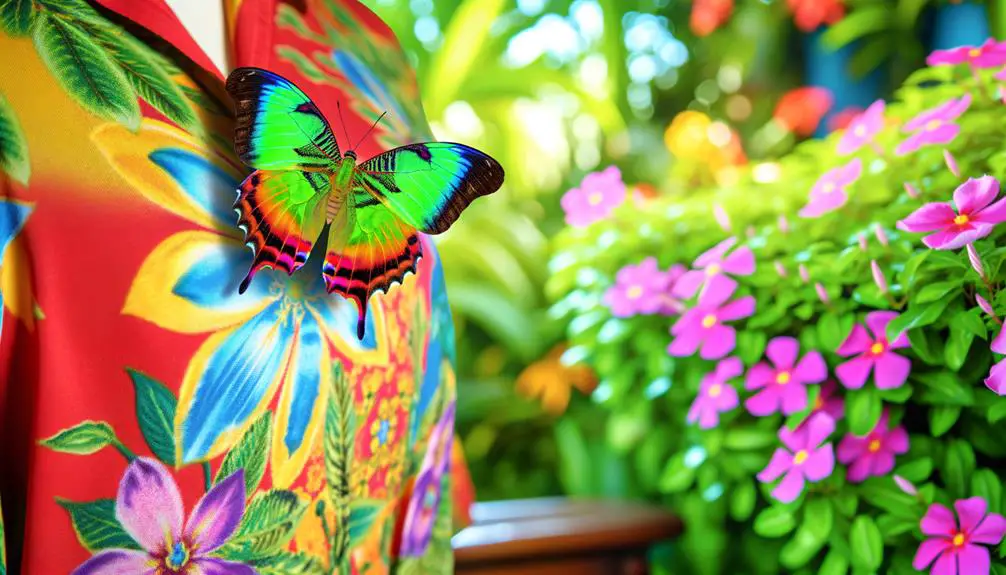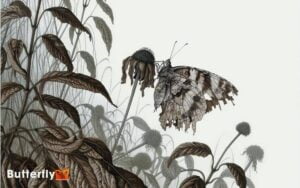Do Butterflies Land on You for Sweat Scientifically?
Butterflies land on humans for several scientific reasons, primarily their attraction to the salts and minerals in sweat, which are essential for their metabolic processes and reproductive health. Brightly colored clothing also mimics the visual cues of nectar-rich flowers, enticing butterflies with their striking hues.
Additionally, floral pattern mimicry on human attire resembles the designs butterflies naturally seek for foraging. These insects use sophisticated sensory mechanisms, including compound eyes and chemoreceptors, to detect nutrients and suitable landing spots.
Environmental factors such as temperature and humidity also influence this behavior. By exploring butterfly ecology, one can understand these fascinating interactions more deeply.

Key Takeaways
- Butterflies land on humans to obtain essential minerals and salts from sweat.
- Brightly colored clothing attracts butterflies by mimicking natural floral signals.
- Floral pattern mimicry on clothing can simulate nectar sources, drawing butterflies.
- Butterflies use their sensory perception to detect salts and minerals on human skin.
Attraction to Sweat

Butterflies are often drawn to human sweat due to the presence of essential minerals and salts that they need for survival. These insects, particularly males, actively seek out sodium, which plays a vital role in their reproductive health and overall physiology.
Sodium, along with other trace elements like potassium and calcium, aids in various metabolic processes. When butterflies land on human skin, they use their proboscis to absorb these nutrients from sweat.
This behavior, known as mud-puddling, extends beyond humans to other sources such as animal dung, urine, and even moist soil. The affinity for these minerals highlights an ecological necessity, as butterflies often inhabit environments where such resources are scarce, making human perspiration a valuable alternative.
Role of Bright Colors
Bright colors play a significant role in attracting butterflies, serving as visual cues that guide these insects to potential sources of nectar, mates, and suitable habitats.
The vivid hues of flowers and other natural elements are perceived by butterflies through their specialized vision, which is attuned to detect a broad spectrum of colors, particularly in the ultraviolet range. This sensitivity allows butterflies to efficiently locate essential resources.
Additionally, bright colors can signal the presence of other butterflies, facilitating mating opportunities. When humans wear brightly colored clothing, they inadvertently mimic these natural signals, drawing the attention of butterflies.
The interaction underscores the importance of color perception in the ecological behaviors and survival strategies of these delicate insects.
Floral Pattern Mimicry

Floral pattern mimicry is a phenomenon where certain patterns on surfaces, such as clothing or objects, resemble the intricate designs found on flowers, thereby attracting butterflies by simulating their natural foraging environment. This mimicry can lead to increased butterfly interactions with humans, as the insects are drawn to these familiar patterns.
| Aspect | Details |
|---|---|
| Pattern Complexity | Mimics the multicolored and detailed designs of flowers |
| Butterfly Attraction | Enhances the likelihood of butterflies landing on surfaces |
| Natural Foraging Cues | Replicates the visual cues butterflies use to locate nectar |
These observations highlight how human-made patterns can influence butterfly behavior, bridging natural and artificial elements to create compelling interactions. Understanding this mimicry provides insight into butterfly ecology and their sensory-based decision-making processes.
Sensory Perception
Frequently, the intricate sensory mechanisms of butterflies play a crucial role in their ability to navigate and interact with their environment. These mechanisms help butterflies detect subtle changes in temperature, humidity, and even the chemical composition of the air, allowing them to find food sources and suitable habitats. Their antennae and specialized receptors enable them to communicate and avoid predators efficiently. Understanding these sensory adaptations also provides insight into butterfly lifespan facts, as factors like environmental conditions and predation risks directly impact their survival and longevity.
Butterflies possess highly developed sensory organs, including compound eyes that detect ultraviolet light and intricate olfactory receptors located on their antennae. These sensory capabilities allow them to locate food sources, potential mates, and suitable habitats.
Additionally, chemoreceptors on their feet enable butterflies to taste surfaces upon landing, guiding them toward nutrient-rich areas. This sophisticated sensory perception system allows butterflies to efficiently process environmental stimuli and make informed decisions.
When butterflies land on humans, it is often a result of detecting salts and minerals through their chemoreceptors, which are essential for their metabolic processes and overall health.
Environmental Factors

The presence and behavior of butterflies are greatly influenced by a myriad of environmental factors, including temperature, humidity, and the availability of resources such as nectar and suitable host plants. These factors dictate their activity levels and migratory patterns, directly impacting their interactions with humans. For instance, butterflies are more likely to be active and seek out resources during ideal temperature and humidity conditions. Additionally, human presence can inadvertently provide salt and moisture, essential for their survival, which they may obtain from sweat.
Key environmental factors include:
- Temperature: Influences metabolic rates and flight activity.
- Humidity: Affects their hydration and survival.
- Resource Availability: Determines their foraging and landing behavior.
Understanding these variables aids in comprehending butterfly behavior thoroughly.
Conclusion
To summarize, butterflies landing on individuals can be attributed to various scientific factors, including attraction to sweat for essential nutrients, the allure of bright colors, and floral pattern mimicry.
Additionally, their highly sensitive sensory perception and certain environmental conditions play pivotal roles.
These enchanting creatures, seemingly drawn as if by an otherworldly magnet, interact with humans in a complex dance of ecological interactions and evolutionary adaptations, underscoring the intricate balance of nature.





